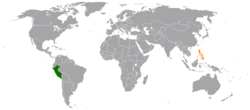Peru–Philippines relations
Peru–Philippines relations refers to the diplomatic relations between Peru and the Philippines. The Philippines and Peru are both predominantly Roman Catholic countries and were ruled by the Spanish Empire for hundreds of years.
 | |
Peru |
Philippines |
|---|---|
Trade relations
During the colonial period, there was significant trade between the two colonies. But there were frequent shifts and reversals of the trade volumes. Following the Spanish conquest of the Philippines in 1560, the islands became a focal point of trans-Pacific trade between Peru and China. Large quantities of silver was exported from Peru, whilst luxury goods such as silk was imported from China via the Philippines. However, in 1581 the Spanish crown awarded monopoly to the port of Acapulco for the trade over the Pacific.[1] However, the traders of Peru continued to trade with the Philippines, in violation of the Royal Decree.[2] Gonzalo Ronquillo de Peñalosa, the governor-general of the Philippines, sent galleons to Peru in 1581 and 1582 carrying the message that trade with Manila was illegal.[2] The smuggling of Chinese goods to Peru involved both Peruvian merchants and politicians.[3]
As of the early 17th century, there were significant imports of Chinese goods to the cities of Lima and Potosí. The peak year was 1602, when the imports from Asia was estimated at a value of 5 million pesos.[4]
In 1793 the Philippines Company was given permission to resume exports to Peru.[5]
Later years
In 2008, Former Philippine President Gloria Macapagal-Arroyo and Former Peruvian President Alan García held bilateral talks and shared commonalities talking about the kinship between their two countries. Following on the meeting of the two Presidents, it was announced in 2008 that the re-introduction of the Spanish language in Philippine schools in 2009 would be a very timely move as the Philippines and Peru had agreed to expand their diplomatic, bilateral and trade relations.[6] In 2009, a Philippines Department of Education order titled a Mother Tongue-Based Multilingual Education (MLE) detailed a planned educational methodology which did not involve the Spanish language.[7]
References
- John Robert Fisher (1997). The Economic Aspects of Spanish Imperialism in America, 1492-1810. Liverpool University Press. pp. 65–66. ISBN 978-0-85323-552-1.
- Jose Maria S. Luengo (1996). A History of the Manila-Acapulco Slave Trade (1565-1815). Mater Dei Publications. p. 132.
- Shirley Fish (18 May 2011). The Manila-Acapulco Galleons : The Treasure Ships of the Pacific: With an Annotated List of the Transpacific Galleons 1565-1815. AuthorHouse. p. 48. ISBN 978-1-4567-7543-8.
- Charles Poor Kindleberger (1989). Spenders and Hoarders: The World Distribution of Spanish American Silver, 1550-1750. Institute of Southeast Asian Studies. p. 25. ISBN 978-981-3035-28-7.
- John Robert Fisher (1997). The Economic Aspects of Spanish Imperialism in America, 1492-1810. Liverpool University Press. p. 152. ISBN 978-0-85323-552-1.
- "RP, PERU to expand trade relations". Bohol News Daily. Archived from the original on 2014-11-29. Retrieved 2008-11-28.
- DepEd Order 74 of 2009 (PDF) (archived from the original on 2012-06-16)

